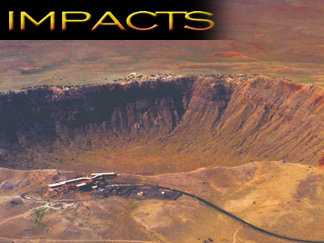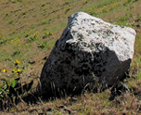features
 |
Unraveling
the Chicxulub Case
On the Yucatan Peninsula in Mexico, geologists are drilling one of Earth's
three largest impact structures, hoping to reveal clues about a devastating
event linked to the extinction of the dinosaurs 65 million years ago.
Megan Sever
|
Coring
the Chesapeake Bay Impact Crater
An extraterrestrial impact 36 million years ago left a lasting impression
in the Chesapeake Bay and continues to affect the region's environment
today.
C. Wylie Poag
|
The
Many Faces of the Alamo Breccia
In Nevada, with no visible crater, researchers are piecing together
evidence of a 370 million-year-old impact based on widely dispersed
pieces of rock.
John E. Warme
|
Impacts
in Space and on Earth: An Interview with Carolyn Shoemaker
Carolyn Shoemaker reflects on a lifetime of work with her husband Gene,
uncovering impact structures around the world.
Lisa M. Pinsker |
|
news.html

January 26
Mars Update: Opportunity lands
January 19
Travels in Geology: America's garden island
January 16
Saltier sea
January 14
Bush retools space program
January 9
Charcoal clues in dinosaur debate
January 6
Mars geologist in action
Webextras
Archive
 News
Notes News
Notes
Rocky boulders
in Washington
Longer polar ice record
Cooked minerals resemble life
Green minerals on the Red Planet
Climate aids mountain building
Geophenomena
Research
out of the ashes
Seafloor steam carries lava
flows
 Taking
a trip?
Check out Travels in Geology to find geologically significant places to
visit. Taking
a trip?
Check out Travels in Geology to find geologically significant places to
visit. |
|
|
views.html
Comment
Asteroid Futures
Although the near-term risk of a catastrophic asteroid collision on Earth may
be slim, scientists acting now can provide insurance to protect future generations.
Richard P. Binzel
Political Scene
The 2003 Energy Bill: Did
Politics Trump Science?
In her first months on Capitol Hill, a new congressional science fellow is already
realizing that all politics are local, particularly when it comes to the nation's
energy strategy.
Eloise Kendy
Education & Outreach
Earth Science Week in
the Limelight
This year's Earth Science Week featured contests and events to celebrate the
role scientists play in monitoring Earth.
Cynthia Martinez
Geologic
Column
A Soft Rock Tourist at the
Gates of Hell
Become a daredevil volcanologist through the eyes of four recently published
books.
Fred Schwab
|
departments
Profiles
W.
Jason Morgan: Geophysics guru honored
Energy & Resources
Controversial
mineral deposit sold
Mineral Resource of the Month: Lead
 Check out this month's
Energy Notes!
Check out this month's
Energy Notes!
Geomedia
Life
on a Young Planet
On
the Web
|
cover
 ON
THE COVER ON
THE COVER
With a diameter of about 1.2 kilometers, Meteor
Crater (also known as Barringer Crater) in northern Arizona was the first terrestrial
impact crater researchers recognized as such, based on studies in the 1950s by
Gene Shoemaker and colleagues. Today, scientists have identified about 170 impact
structures throughout the world formed by extraterrestrial impacts. Read more
on Impacts in Space and on Earth and throughout
this issue. Image copyright of Meteor Crater Enterprises. Right top: This
Advanced Spaceborne Thermal Emission and Reflection Radiometer image reveals the
fire fronts of the Old and Grand Prix fires that raged in the San Bernardino Mountains
at the end of October 2003. Vegetation is green, burned area is red, smoke is
blue, and the fire front is pink. Read the story. Image
courtesy U.S./Japan ASTER Science Team.
|
announcing
Coming Soon...
Later this month:
Geologic Column: A Soft Rock Tourist
at the Gates of Hell
February:
Geoarcheology

Want to write science news?
Apply to be a Geotimes summer
intern!
Visit our
searchable archive.

|


 ON
THE COVER
ON
THE COVER 